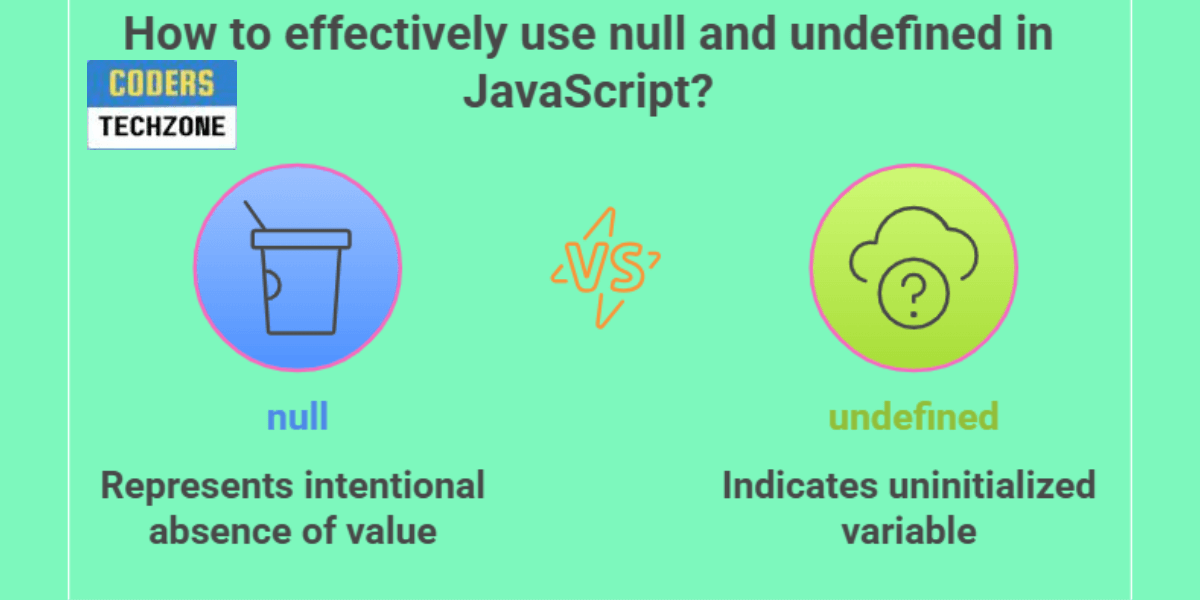If you are coding in JavaScript for just 1 month or more, I am 100% sure that you already experienced the puzzle between null and undefined. These two values may be similar, but they act differently. Many developers misuse those that can leading to unexpected bugs and errors for sure.
Table of Contents
In this article, we will identify the key differences, share real-life code examples, and list all best practices to avoid common bugs or errors. By the end, you’ll never be confused about null and undefined again!

What is undefined in JavaScript?
Definition
undefined is a special value in JavaScript that represents a variable that has been declared but not assigned a value.

Examples
1. Unassigned Variable
let x;
console.log(x); // undefined- The variable
xis declared but not assigned a value, so JavaScript considers it toundefined.
2. Missing Function Parameter
function greet(name) {
console.log("Hello, " + name);
}
greet(); // Hello, undefined- Since no argument was passed,
nameisundefined.
3. Accessing Non-Existent Object Properties
let person = { name: "Alice" };
console.log(person.age); // undefined- The property
agedoesn’t exist in the object, so JavaScript returnsundefined.
📌 Tip:
Always check if a value is undefined before using it to prevent errors.
What is null in JavaScript?

Definition
null is an intentional absence of value. It is explicitly assigned to a variable to indicate “no value.”
Examples
1. Assigning null to a Variable
let data = null;
console.log(data); // null- Here, we intentionally set
datatonullto indicate that it has no value.
2. Resetting an Object
let user = { name: "John" };
user = null;
console.log(user); // null- Setting
user = null;release memory by removing the reference to the object. Mind it bro!!
3. Null in DOM Elements
console.log(document.getElementById("nonexistent")); // null- If an element doesn’t exist in the DOM,
getElementById()returnsnull.
📌 Tip:
Use null when you deliberately want to indicate “no value” instead of leaving it undefined.
Key Differences Between null and undefined

| Feature | undefined | null |
|---|---|---|
| Type | Primitive | Object |
| Default Value? | Yes, variables get undefined if no value is assigned | No, must be explicitly assigned |
| Intentional? | No, it happens by default | Yes, assigned on purpose |
| Used in? | Unassigned variables, missing object properties, function parameters | Empty object references, DOM lookups, resetting values |
📌 Tip:
Always assign null explicitly if you want to indicate a missing value instead of leaving it undefined.
Common Mistakes and How to Avoid Them
❌ Mistake 1: Confusing null and undefined in Conditionals
if (variable) {
console.log("Value exists");
} else {
console.log("Value is missing");
}- This works most of the time, but if
variableis0or""(empty string), it will also be treated as false.
✅ Best Practice: Use == null to check for both null and undefined.
if (variable == null) {
console.log("Value is missing");
}❌ Mistake 2: Using typeof to Check for null
console.log(typeof null); // "object"nullis not an object but is incorrectly categorized as one due to a long-standing JavaScript bug.
✅ Best Practice: Use === null to check for null.
if (variable === null) {
console.log("Variable is null");
}❌ Mistake 3: Forgetting to Handle undefined in Function Parameters
function greet(name) {
return "Hello, " + name;
}
console.log(greet()); // Hello, undefined✅ Best Practice: Set default values.
function greet(name = "Guest") {
return "Hello, " + name;
}
console.log(greet()); // Hello, GuestWhy Does This Matter in 2025? 🚀
While using JavaScript, understanding null and undefined is crucial for:
- Writing cleaner, bug-free code
- Avoiding unnecessary
undefinederrors - Improving performance by properly managing memory
How Modern JavaScript Handles This
- Optional Chaining (
?.) – Avoidsundefinederrors:
let user = {};
console.log(user.profile?.age); // undefined (No error!)- Nullish Coalescing (
??) – Provides fallback values:
let username;
console.log(username ?? "Anonymous"); // Anonymous5 important FAQs about null and undefined in JavaScript
1. What is the difference between null and undefined in JavaScript?
undefined indicates that a variable has been declared but has not yet been assigned a value. It’s the default state of uninitialized variables.
null is an assignment value that represents the intentional absence of any object value. Developers assign null to a variable to indicate that it should have no value.
2. How do null and undefined differ in terms of type?
Using the typeof operator: typeof undefined returns "undefined".typeof null returns "object". This is a well-known quirk in JavaScript, as null is not actually an object.
3. Are null and undefined equal in comparisons?
Using the loose equality operator (==): null == undefined evaluates to true.
Using the strict equality operator (===): null === undefined evaluates to false.
This is because == performs type coercion, whereas === checks for both value and type equality.
4. When should I use null vs. undefined?
Use undefined when a variable is declared but not yet assigned a value, or to indicate the absence of a value in function parameters.
Use null when you want to explicitly indicate that a variable should have no value. This is a deliberate assignment to show the intentional absence of any object value.
5. How do null and undefined behave in arithmetic operations?
null is coerced to 0 in numeric contexts: null + 1 evaluates to 1.
undefined is coerced to NaN (Not-a-Number): undefined + 1 evaluates to NaN.
This difference can lead to unexpected results if not handled properly.
Final Thoughts 💡
- Use
undefinedfor uninitialized variables. - Use
nullwhen you want to indicate “no value.” - Handle missing values carefully using optional chaining and default parameters.
📌 Tip:
Always check for null and undefined before using a variable.
if (value !== null && value !== undefined) {
console.log("Safe to use value!");
}🚀 Now you know the difference! Share this guide with your known developers and never misuse null and undefined again!
🏋️♂️ Discover Code Blocks From 20+ yrs JS Expert
💥 Asp.net C# Developer
🏆 Solution Architect
👨✈️ Database Administrator
📢 Speaker
🎓 MCTS since 2009







Leave a Reply